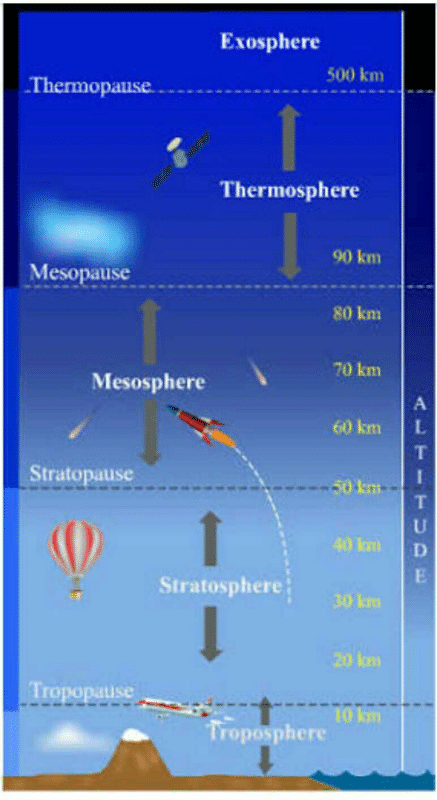Class 6 Exam > Class 6 Questions > Draw the diagram of layers of the atmosphere ...
Start Learning for Free
Draw the diagram of layers of the atmosphere and also explain
Most Upvoted Answer
Draw the diagram of layers of the atmosphere and also explain

Community Answer
Draw the diagram of layers of the atmosphere and also explain
Layers of the Atmosphere
Troposphere
The troposphere is the lowest layer of the atmosphere, extending from the earth's surface up to about 8-15 kilometers. It is where all weather occurs, including clouds, rain, and snow. The temperature in the troposphere decreases as altitude increases.
Stratosphere
The stratosphere is the second layer of the atmosphere, extending from the top of the troposphere to about 50 kilometers. The ozone layer is found in the upper part of the stratosphere, which absorbs harmful ultraviolet radiation from the sun. The temperature in the stratosphere increases as altitude increases.
Mesosphere
The mesosphere is the third layer of the atmosphere, extending from the top of the stratosphere to about 85 kilometers. It is the coldest layer of the atmosphere, with temperatures dropping as low as -100°C. Meteoroids burn up in this layer, producing shooting stars.
Thermosphere
The thermosphere is the uppermost layer of the atmosphere, extending from the top of the mesosphere to the edge of space. It is the hottest layer of the atmosphere, with temperatures reaching up to 2,000°C. The auroras occur in the thermosphere due to the interaction between the Earth's magnetic field and charged particles from the sun.
In conclusion, the atmosphere is divided into four layers, each with unique characteristics and functions. The troposphere is where all weather occurs, the stratosphere contains the ozone layer, the mesosphere is the coldest layer, and the thermosphere is the hottest layer. Understanding the layers of the atmosphere is crucial for understanding Earth's climate and weather patterns.
- Troposphere
- Stratosphere
- Mesosphere
- Thermosphere
Troposphere
The troposphere is the lowest layer of the atmosphere, extending from the earth's surface up to about 8-15 kilometers. It is where all weather occurs, including clouds, rain, and snow. The temperature in the troposphere decreases as altitude increases.
Stratosphere
The stratosphere is the second layer of the atmosphere, extending from the top of the troposphere to about 50 kilometers. The ozone layer is found in the upper part of the stratosphere, which absorbs harmful ultraviolet radiation from the sun. The temperature in the stratosphere increases as altitude increases.
Mesosphere
The mesosphere is the third layer of the atmosphere, extending from the top of the stratosphere to about 85 kilometers. It is the coldest layer of the atmosphere, with temperatures dropping as low as -100°C. Meteoroids burn up in this layer, producing shooting stars.
Thermosphere
The thermosphere is the uppermost layer of the atmosphere, extending from the top of the mesosphere to the edge of space. It is the hottest layer of the atmosphere, with temperatures reaching up to 2,000°C. The auroras occur in the thermosphere due to the interaction between the Earth's magnetic field and charged particles from the sun.
In conclusion, the atmosphere is divided into four layers, each with unique characteristics and functions. The troposphere is where all weather occurs, the stratosphere contains the ozone layer, the mesosphere is the coldest layer, and the thermosphere is the hottest layer. Understanding the layers of the atmosphere is crucial for understanding Earth's climate and weather patterns.
Attention Class 6 Students!
To make sure you are not studying endlessly, EduRev has designed Class 6 study material, with Structured Courses, Videos, & Test Series. Plus get personalized analysis, doubt solving and improvement plans to achieve a great score in Class 6.

|
Explore Courses for Class 6 exam
|

|
Similar Class 6 Doubts
Draw the diagram of layers of the atmosphere and also explain
Question Description
Draw the diagram of layers of the atmosphere and also explain for Class 6 2024 is part of Class 6 preparation. The Question and answers have been prepared according to the Class 6 exam syllabus. Information about Draw the diagram of layers of the atmosphere and also explain covers all topics & solutions for Class 6 2024 Exam. Find important definitions, questions, meanings, examples, exercises and tests below for Draw the diagram of layers of the atmosphere and also explain.
Draw the diagram of layers of the atmosphere and also explain for Class 6 2024 is part of Class 6 preparation. The Question and answers have been prepared according to the Class 6 exam syllabus. Information about Draw the diagram of layers of the atmosphere and also explain covers all topics & solutions for Class 6 2024 Exam. Find important definitions, questions, meanings, examples, exercises and tests below for Draw the diagram of layers of the atmosphere and also explain.
Solutions for Draw the diagram of layers of the atmosphere and also explain in English & in Hindi are available as part of our courses for Class 6.
Download more important topics, notes, lectures and mock test series for Class 6 Exam by signing up for free.
Here you can find the meaning of Draw the diagram of layers of the atmosphere and also explain defined & explained in the simplest way possible. Besides giving the explanation of
Draw the diagram of layers of the atmosphere and also explain, a detailed solution for Draw the diagram of layers of the atmosphere and also explain has been provided alongside types of Draw the diagram of layers of the atmosphere and also explain theory, EduRev gives you an
ample number of questions to practice Draw the diagram of layers of the atmosphere and also explain tests, examples and also practice Class 6 tests.

|
Explore Courses for Class 6 exam
|

|
Suggested Free Tests
Signup for Free!
Signup to see your scores go up within 7 days! Learn & Practice with 1000+ FREE Notes, Videos & Tests.

























